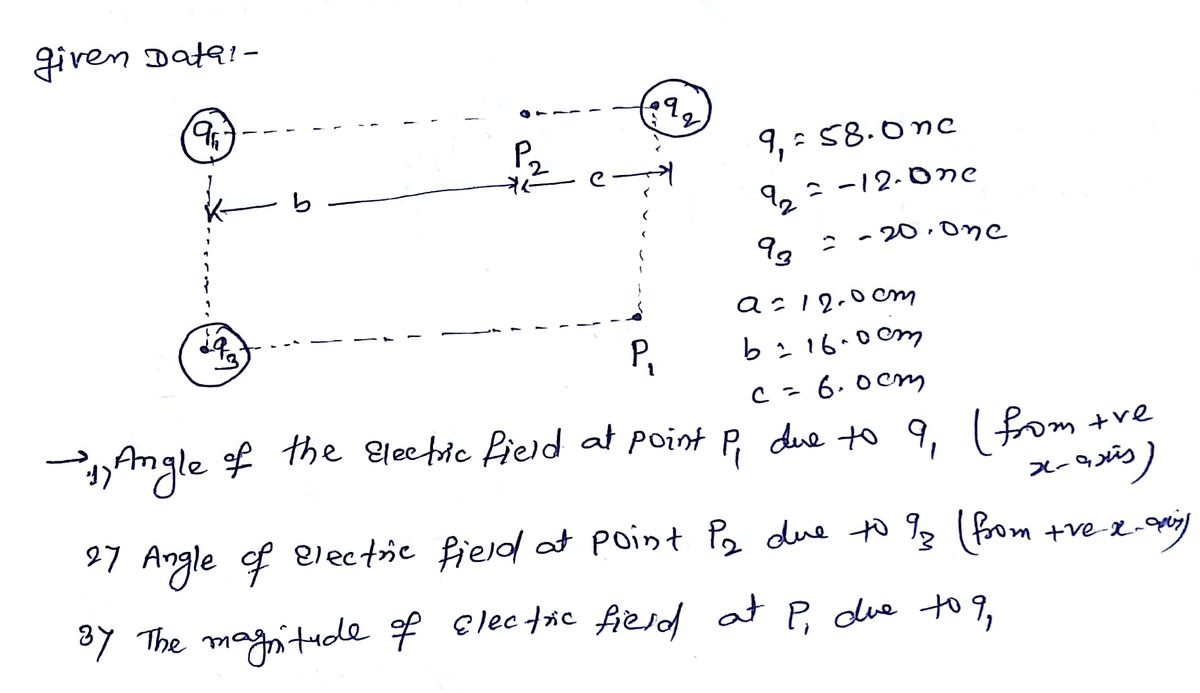
Concept explainers
1)The angle of the electric field at point P1 due only to q1, as measured from the positive x-axis, in degrees and to three decimal places, is
2)The angle of the electric field at point P2 due only to q3, as measured from the positive x-axis, in degrees and to three decimal places, is
3)The magnitude of the electric field at point P1 due to q1, in N/C and to one decimal place, is
4)The angle of the total electric field at point P1, as measured from the positive y-axis, in degrees and to three decimal places, is
5)A charge q4 is placed at point P1. If q4=420.00000 μC, the magnitude of the electric force acting on q4 due to the other charges, in N and to three decimal places, is

As per our company guidelines we are supposed to answer only first 3-sub part. Kindly repost other parts in next question.

Step by stepSolved in 3 steps with 3 images

- Consider a system of two charges where the first charge is on the positive x-axis and the second charge is on the positive y-axis. If these two charges produce electric fields at the origin given by (2.61, 0) N/C and (0, -2.61) N/C, respectively, determine the following. (a) the magnitude of the resultant electric field at the origin, measured counterclockwise from the positive x-axis N/C (b) the direction of the resultant electric field at the origin, measured counterclockwise from the positive x-axis ° counterclockwise from the +x-axis (c) What would be the magnitude of the force on a 1.34 x 10-⁹ C charge placed at the origin? Narrow_forwardCalculate the magnitude of the electric field at one corner of a square 1.82 m on a side if the other three corners are occupied by 6.25×10−6 C charges. Express your answer to three significant figures and include the appropriate units.arrow_forward15.arrow_forward
- Consider two point charges located at the corners of a square with a side length a = 20 cm as shown in the following figure, where q1 = 5 µC. and q2 = -10 µC. y 20 cm 92 k----- 20 cm -----> The vector electric field (2 ) that q, and q2 together create at point P is Оa. (2.41 — 3.8)х 109]N/C O b. [(0.8î – 1.45) × 10ʻ]N/C O. [(0.4î – 1.85) × 10ʻ]N/C O d. [(1.8î – 0.45) × 10°]N/Carrow_forwardDraw the graph and show complete solutionsLet: q1 = +8 μC , at the originq2 = +6 μC , 6 meters to the right of the originq3 = -86 μC , 8 meters above q2q4 = -0.75 μC , 8 meters above the origin Find the magnitude and direction of the total electric force and total electric field at q3.arrow_forwardCalculate the total electric field at point A or B in the figure due to both charges, Q1 and Q2.arrow_forward
- Give an expression for the electric field strength ?E at a point in terms of the charge ?q and distance ?r from the charge to that point. Use ?k for 14??014πε0 (i.e. ?≡14??0k≡14πε0). Use the following notation (without the quotes): "/" for division, "*" for multiplication, "+" an "-" as usual. For powers used "^2", while for square root use "sqrt". To indicate that square root applies to the whole expression use brackets - for example, for ??‾‾‾‾√AB use sqrt(A*B). For Greek letters such as ?π, ?α etc. use pi, alpha. For example to get 1??2???‾‾‾‾√1πA2BAB use 1/pi*A^2/B*sqrt(AB). Please use the exact variables given in the conditions of the problem: e.g if ?L is given, then do not use ?l.arrow_forwardA uniform electric field exists everywhere in the x, y plane. This electric field has a magnitude of 5200 N/C and is directed in the positive x direction. A point charge -8.7 x 10⁹ C is placed at the origin. Find the magnitude of the net electric field at (a) x = -0.19 m, (b) x=+0.19 m, and (c) y = +0.19 m. (a) Number i (b) Number i (c) Number i Units Units Units + ¤ #arrow_forwardFind the x and y components of the electric field produced by 91 and 92 in the figure shown below at point A and point B. (Take q₁ = 2.16 μC and q2 = -1.09 μC.) y, m 3 2 1 B 914 Point A Ex= Ey= Point B Ex = Ey = I 1 2 3 4 -x, marrow_forward
- Two point charges of 8.85 x 10° C are situated in a Cartesian coordinate system. One charge is at the origin while the other is at (0.72, 0) m. What is the magnitude of the net electric field at the location (0, 0.77) m?arrow_forwardIn the figure below, the electric field at the origin is zero. 1) If q1 is 1.00×10^−7 C, what is q2? (Express your answer to three significant figures.)arrow_forward
 College PhysicsPhysicsISBN:9781305952300Author:Raymond A. Serway, Chris VuillePublisher:Cengage Learning
College PhysicsPhysicsISBN:9781305952300Author:Raymond A. Serway, Chris VuillePublisher:Cengage Learning University Physics (14th Edition)PhysicsISBN:9780133969290Author:Hugh D. Young, Roger A. FreedmanPublisher:PEARSON
University Physics (14th Edition)PhysicsISBN:9780133969290Author:Hugh D. Young, Roger A. FreedmanPublisher:PEARSON Introduction To Quantum MechanicsPhysicsISBN:9781107189638Author:Griffiths, David J., Schroeter, Darrell F.Publisher:Cambridge University Press
Introduction To Quantum MechanicsPhysicsISBN:9781107189638Author:Griffiths, David J., Schroeter, Darrell F.Publisher:Cambridge University Press Physics for Scientists and EngineersPhysicsISBN:9781337553278Author:Raymond A. Serway, John W. JewettPublisher:Cengage Learning
Physics for Scientists and EngineersPhysicsISBN:9781337553278Author:Raymond A. Serway, John W. JewettPublisher:Cengage Learning Lecture- Tutorials for Introductory AstronomyPhysicsISBN:9780321820464Author:Edward E. Prather, Tim P. Slater, Jeff P. Adams, Gina BrissendenPublisher:Addison-Wesley
Lecture- Tutorials for Introductory AstronomyPhysicsISBN:9780321820464Author:Edward E. Prather, Tim P. Slater, Jeff P. Adams, Gina BrissendenPublisher:Addison-Wesley College Physics: A Strategic Approach (4th Editio...PhysicsISBN:9780134609034Author:Randall D. Knight (Professor Emeritus), Brian Jones, Stuart FieldPublisher:PEARSON
College Physics: A Strategic Approach (4th Editio...PhysicsISBN:9780134609034Author:Randall D. Knight (Professor Emeritus), Brian Jones, Stuart FieldPublisher:PEARSON





